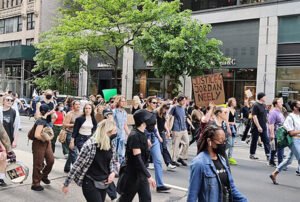
May 22, 2015; The Hill
This op-ed in The Hill co-authored by Jay Ruderman, the president of the Ruderman Family Foundation, and Jo Ann Simons, president and CEO of the Cardinal Cushing Centers in Massachusetts, is truly important. In part, it’s because the authors point out something that doesn’t get much attention in mainstream (or, sadly, nonprofit) press coverage of police brutality: Persons with disabilities are its all-too-frequent victims.
Ruderman and Simons write about the deaths of Ethan Saylor, a 26-year old with Down syndrome who died of asphyxiation after being dragged by police from his seat in a theater in Frederick, Maryland, in 2013, and James Boyd, a homeless man (reportedly diagnosed with schizophrenia) who was shot and killed by police officers in Albuquerque in March of 2014.
“To be sure, stories about Ethan and James, as well as others involving people with disabilities, sometimes result in a spate of media coverage for a time, some localized protest and investigations by federal authorities,” Ruderman and Simons write. “But they hardly trigger the national outrage they deserve.”
Recent cases of alleged police brutality toward blacks intersect with the presence of disabilities intersect in some striking ways. Ruderman and Simons note, for example, that Freddie Gray may have had an intellectual disability due to the effects of lead poisoning. In Boston, there was the case of 41-year-old Wilfredo Justiniano, suffering from schizophrenia, who despite being “armed” only with a writing pen was killed in 2013 by a police officer.
The police treatment of persons with disabilities should be a national concern. Last year, KQED reported that more than half of all police killings in San Francisco between 2005 and 2013 had the mental illness of the victims as a “contributing factor.” According to other studies, the rate of police killings involving persons with mental illness is about the same across the nation.
Sign up for our free newsletters
Subscribe to NPQ's newsletters to have our top stories delivered directly to your inbox.
By signing up, you agree to our privacy policy and terms of use, and to receive messages from NPQ and our partners.
The Supreme Court recently ruled that the police were immune from lawsuitsin a case regarding a police shooting of a mentally ill woman in a San Francisco group home, but sent the case back to lower courts to consider whether the alleged use of excessive force by the police constituted a violation of the Americans with Disabilities Act, which requires authorities to “reasonably accommodate” a person’s physical or mental disability. The amicus brief filed by the American Civil Liberties Union in that case (City and County of San Francisco et al. v. Teresa Sheehan) recounted many additional kinds of disabilities that have been connected to police shootings:
- Persons who are deaf or hard of hearing, who sometimes are perceived by police as uncooperative or when handcuffed are unable to use sign language to communicate
- Persons with epilepsy or cerebral palsy, who are sometimes assumed by police to have taken drugs or become intoxicated
- Persons with autism or Asperger’s, who might repeat police officers’ statements or be unable to maintain eye contact, which police might construe as uncooperative or hostile behavior
- Persons with intellectual or psychiatric difficulties, who are “often shot or beaten when they cannot follow the orders of police officers”
Ruderman and Simons also cite examples of police abuse of school children with disabilities. NPQ covered this specifically in light of the final speech from the senate floor of Senator Tom Harkin, whose Senate committee released a heart-rending report on the barbaric behavior of some school systems toward children with disabilities. “Cases like these suggest that police need to go further to understand how best to approach persons with disabilities,” Ruderman and Simons write. “Force is often the worst option.”
The authors argue that cutbacks in human services have forced police to step into the role of social workers. In many cases, police are called in to intervene when the problem is really an instance of mental or emotional health crisis—a task they may not be adequately trained to perform and might be reasonably reluctant to fulfill. Correctly, Ruderman and Simons present this issue as a question of “the rights of many…among us who…face severe disadvantage and marginalization” due to their physical, mental, and emotional disabilities.
When it comes to the rights of persons with disabilities in their dealings with police, the national conversation is pretty sparse. Witness the very limited references to and recommendations about policing practices in this arena in the White House task force report on 21st-century policing:
- The report called for police to use physical control equipment as a last resort with all vulnerable populations, including pregnant women, children, the elderly, and persons with disabilities (action item 1.5.4).
- It called for nonpunitive “sentinel event” peer reviews of police cases involving wrongful arrests, “near miss” acquittals, wrongful releases of dangerous criminals, and of releases of persons with mental disabilities (in the explanation of recommendation 2.3).
- Recommendation 2.13 called on police to prohibit profiling based on race, ethnicity, national origin, religion, age, gender, immigration status, sexual orientation, sexual identity, and disability.
- Action item 3.2.3 directed police to use new technology to better serve people with special needs or disabilities.
- Model police policies and practices should be posted and accessible to persons with disabilities (in the explanation of recommendation 3.5).
It doesn’t seem like the task force had a particularly vigorous discussion of police-related deaths of persons with disabilities, given the statistics that exist. One hopes that, as Ruderman and Simons warn against, we don’t “wait for the next casualty” for this necessary national conversation to start
Addendum: Last week, a Cleveland judge declined to convict the first of several Cleveland police officers to face trial for having killed Timothy Russell and Malissa Williams—both unarmed—in a barrage of 137 shots, including several fired through the windshield by Officer Michael Brelo from the hood of the victims’ car. Brelo is white and the two victims are black, but in addition, both Russell and Williams were homeless, mentally ill, and under the influence of drugs the night they died. According to the Washington Post, Russell was bipolar and Williams was diagnosed as schizophrenic.—Rick Cohen
[Full Disclosure: The author facilitated a discussion among disability rights organizations that was sponsored by the Ruderman Family Foundation]












